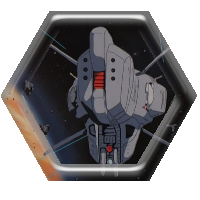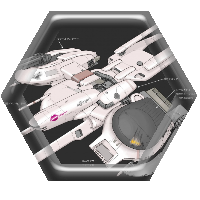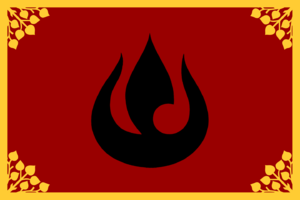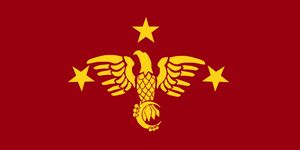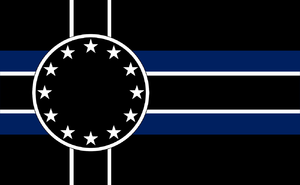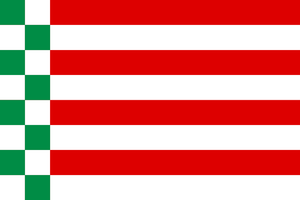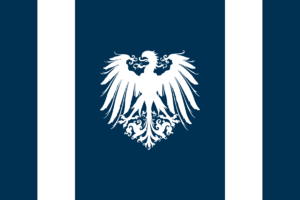Difference between revisions of "Princesses of the Cosmos"
m (→Independents) |
|||
| Line 385: | Line 385: | ||
<br> | <br> | ||
<br> | <br> | ||
| − | [[Image:Flag_Dorado. | + | [[Image:Flag_Dorado.png|thumb]] |
'''Dorado'''<br> | '''Dorado'''<br> | ||
<br> | <br> | ||
| Line 568: | Line 568: | ||
<br> | <br> | ||
<br> | <br> | ||
| − | [[Image:Flag_Nacio. | + | [[Image:Flag_Nacio.png|thumb]] |
'''Nova Nacio'''<br> | '''Nova Nacio'''<br> | ||
<br> | <br> | ||
Revision as of 22:09, 16 November 2019
Character Design
XP
Stats
- Body
- Intellect
- Charisma
- Leadership
Skills
- Rulership
- Eye for Talent
- Bureaucracy
- Strategy
- Politics
- Courtly Manners
- Ettiquette
- Insinuation
- Seduction
- Sharp Ears
- Warfare
- Navigation
- Gunnery
- Piloting
- Tactics
- Academics
- Eureka!
- Engineering
- Bookishness
- Logistics
- Skullduggery
- Carousing
- Casing
- Thuggery
- Disguise
- Elan
- Pugilism
- Gunfighting
- Equestrianship
- Olympiad
- Backbone
Nemesis
Heroes always have flaws; at the same time heroic flaws can be blessings in disguise. After all, it takes a certain level of ego to stand in front of the Emperor and call out his favorite and no hard-driving cavalry commander is complete without at least a bit of recklessness. As such, Nemesis can be applied both as a negative (either by the GM or exploiting other character's Nemesis as a penalty) or as a positive, applying your own to a roll as a bonus. This is, of course, situational; it is unlikely that Vengeful would apply at high tea, but you never know.
Every time when XP is awarded, you may add or subtract one dot of Nemesis, preferably if said Nemesis had been exercised in the preceeding session.
- Ego
- Reckless
- Lusty
- Vengeful
- Obsessive
- Greedy
- Cowardice
Family
- Born to the Purple: All Rulership skills start at 1 and get +1 to all Rulership skill checks.
- Court Family: All Courtly Manners skills start at 1 and get +1 to all Courtly Manners skill checks.
- Service Family: All Warfare or Academics skills start at 1 and get +1 to all skill checks of the selected skill group.
- Social Climbers: All Skullduggery skills start at 1 and get +1 to all Skullduggery skill checks.
- Commoner: All Elan skills start at 1 and get +1 to all Elan skill checks.
Formative
- Heir Apparent: Leadership starts at 3 and get +1 to all Leadership skill checks.
- Military Brat: Body starts at 3 and get +1 to all Body skill checks.
- Finishing School: Intellect starts at 3 and get +1 to all Intellect skill checks.
- Wild Child: Charisma starts at 3 and get +1 to all Charisma skill checks.
Fortune
Assets
Montauk
People of Montauk
Astegar van der Maartin, Baron Krill
Three prawns rampant on sable
70s (appears to be in his 40s), achieved some reknown in the Bast Suppression. Semi-retired, mostly manages his fief which is all of Beta Regio on Montauk.
Fiefs of Montauk
Capital District
Montauk's glittering capital where all the glitterati hang out, probably glitteringly. Also full of shopping, red light districts and various extraterritorial enclaves.
- Money, money, money
- Corruption
- Parties
- Prestige
Fort Montauk
Montauk's primary naval base, it includes various Fleet supply contracts. Also has the planet's main cargo spaceport, a sprawling expanse of concrete aprons, container farms and docking canals.
- Industry
- Spare ships
- Smuggling
Nichols Keel Forge
Montauk's primary (and only?) keelforge. Mostly supplies the civilian market.
- Builds keels
- Keel-building expertise (basic)
- Cost-cut on singlecore keels
The Yards
A dirty, polluted part of Montauk, The Yards are the planet's single largest employer and an important source of spacecraft for the sector. Mostly builds cargo ships, but normally has at least one warship under construction.
- Industry
- Cost cut on warships
- Additional cost cut on reserve-grade warships
Gottlieb Reserve Slips
Roughly fifty wallers are stored here, maintained in ordinary in case of need.
- Free ships, so long as you bring them back
- Light industry
Great Wall Montauk
The northernmost extant of the Great Wall facing the Rift. The forts are seriously dated and probably totally unnecessary, but they also only need skeleton crews.
- Gotta upkeep the forts
- Defensive stipend
- No meaningful income
- No industry
- Can probably shake down Rifter merchants.
The Montauk Lighthouse
Built by the Moai Culture, predating Phoenician arrival in the Cloud. Allows for effective travel across nearby systems.
- Defensive stipend
- No meaningful income
- No industry
- Tries her best
Jarl of the North
A vast tundra stretching to the northern polar icecap, full of braided streams, muskeg, ghost bears, jade falcons and snow ravens.
- Great hunting
- Kinda poor
- Lot of mining
- Liegelord of the Jarldoms for all your cyber-viking mercenary needs
Rapa Nui Islands
Ten thousand tropical islands. Sun, surf and serfs.
- Tourist spot
- Tourist money
- Ancient ruins
- Prestigious among the younger set
Other Sites
The Wormhole
Leads back into core Imperial territory.
Fleet Detachment Montauk
A half-dozen guardships to protect the wormhole, plus the various assorted fleet auxiliaries.
Beta Regio
The large southern hemisphere continent. Fief of Baron Krill.
Cathedral Montauk
The Church's extraterritorial enclave in the capital district. Not just a large and fancy cathedral, but barracks for papal guard too.
Blessed Belt
Granted 99-year parole to highsteaders. Currently in year 46.
- Scum
- Villainy
Rikitea Exclusion Zone
As per Church directive Cardinal Zulu Ten.
- Unspoiled archipelago
- Delta Dust shallows
Assets
- Fief Tax/Wealth
- Personal Wealth
- Fief Industry
- Misc Fief specialties (Rosenritters, keel forge, etc)
- Personal War Craft(s)
- Existing Debt (more points!)
- Clique Connections
- Favours Owed/Family Backing
- Spy Rings
- Skilled Household Staff
- Outside Inflence (summon the Inquisition, borrow a Fleet demisquadron, etc)
- Exceptional Character Abilities
Warships
Wallship
- Standardkeel
- 2 Long Beam
- 1 Plasma Blaster
Cavalry Cruiser
- Jennetkeel
- 1 Long Beam -or- 1 Missile Pod
- 2 Short Beam
- 1 Lance -or- 1 Plasma Blaster
- 4 Dragoon Racks
Dragoon
- Houndkeel
- 2 Burst Guns -or- 1 Short Railgun
Rifter Warbird http://www.ex-astris-scientia.org/scans/caps/ktinga-2-sti.jpg
- Jennetkeel
- 1 Heavy Torpedo
- 1 Short Disruptors
Weapons
Beams
The ubiquitous beam cannon is the most common weapon across known space, produced in vast numbers in a myriad different but very similar models. Beam cannons are favored for their balanced combat performance which is also achieved at low cost.
- Vector Lasers
- The Vector Lasers are the most ubiquitous form of naval artillery in known space; cheap and highly effective. As simple as an optic and a capacitor bank, a projector can quite literally be bolted onto the hull of a ship or in the place of cargo with the only limit being the ship’s generators. The rest of the system is supplied by the already existing keel or vector field – as the laser beam forms it is captured by the ship’s vector field. The vectoring minimizes diffusion even at extreme ranges and in the hands of a skilled gunnery officer the beam can literally chase a target.
- Since a defensive field can not simply refract a vectored laser the resulting interaction often produces a lasting splash or plume of diffusing energy visible even to the naked eye. A good fire control system can “bracket” a target by plotting splashes against the predictions of target movement, substantially improving the accuracy of target motion analysis – and following salvos.
- Short Beam: Range 3/6/9/12. Damage 2D10+5. Accuracy falloff 2/per, damage falloff 2/per from E
- Long Beam: Range 5/10/15/20. Damage 2D10+5. Accuracy falloff 2/per, damage falloff 2/per from E, Double Minimum (5)
Railguns
Kinetic weapons have been in use since time immemorial and while they have been long supplanted by energy weapons they still offer useful service.
- Short Railgun: Range 3/6/9/12. Damage 2D10+5. Accuracy falloff 3/per, halved Deflector effect
- Long Railgun: Range 5/10/15/20. Damage 2D10+5. Accuracy falloff 3/per, halved Deflector effect
- Note: Railguns may load solid shells, which increase their accuracy falloff to 3/per and reduce base range by 1 but Deflector effect is reduced to 1/3rd from 1/2. They also gain +2 armor piercing.
Misc Notes
De-rated keels
Over time and use, keels will slowly degrade. As such, it is a common policy to de-rated keels once they have lost a certain amount of power; this normally happens after two or three decades of regular use or longer for ships on lighter duty. De-rating a keel imposes less stress on it and extends the lifespan significantly; a de-rated keel can often continue operating for another century before it reaches retirement age and is either scrapped or converted to stationary power mode.
As a consequence, the aging out of keels tends to impose a natural lifespan on warships as well. While ships of the wall are generally built with removable keels and shuffle in and out of reserve status as needed, ships of the charge normally instead eliminate this feature as a cost/performance measure. Thus younger ships are normally treated as first-category ships while ones with de-rated keels are instead treated as second-category ships that are less effective on an individual basis. The age of the onboard mechanical systems also contributes.
Fundamental Concepts
- This is a clean-slate reboot of Space Princesses, returning to the very dawn of that game.
- It is focussed more on character adventures, intrigues with imperial cliques and managing the character's demesne.
- The party will also be more coherent as opposed to instant atomization; every PC will likely have some tie to the 'home' system/systems likely by Demesne.
- Ongoing discussion: D20 vs 2D10 vs D10
Character Design
- Characters will be generated with two pools of points
- XP is used for character stats and skills (or just ability-only system?)
- Assets is used for 'mega-aspects' such as a warship, family demesnes or standing, etc
- Assets can be converted to XP/used to buy character-level abilities (Rifter gene-hax!)
- Characters will have solid starting values and in-game growth will be slow.
- Variable ability cost depending on usefulness
- Suggested abilities
- 'Eye for Talent': Boosts ship stats if you get an opportunity to roll out and find good crew
- Suggested abilities
Demesne
One of the key elements of the campaign is Demesne. These provide important resources and need to be managed - essentially nation gameplay (very) lite.
- Resources:
- Wealth: This is mostly money, but also represents attention taken by your factors, etc. It is the main currency of the Demesne level. Wealth is used for buying stuff ranging from ships to personal equipment.
- Industry: This is used for building things (warships mostly!). Demesnes may or may not generate industry, in which case you'll need to pay for the industry too.
- Characters are assumed to have access to effectively unlimited 'common' gear because nobles are rich enough to buy as many M16s as they want, but Wealth is needed for stuff that provides actual bonuses; a Mk XXIV pattern blast-fusil made by Sir Kendrick the Robin-Faced, Master Armsmith of the VI Regency is no easy object to find.
- All actual (bonus-giving) gear should come with names and maybe a history.
- Budget cycle is undefined as of yet
- Characters may take their Demesne' wealth as taxes or may instead take it as loans which have interest but provide much more wealth.
- Welp you're in debt. Keep adventuring!
- Other noble characters might have estates in that situation, so you can squeeze them
Reputation
Reputation is a vitally important 'soft' stat; it is how well you are liked (or DISliked) by various factions and cliques in the Empire or outside. I'm using the term 'Clique' for all of these.
- Each Rep is tracked individually
- Rep can be used in two ways; to provide passive bonuses as levels increase or 'burnt' to provide immediate effects.
- Track both current and absolute (amount added over all time) Reputation. Having very high absolute Rep can still provide some passive bonuses but requires much more than current Rep.
- Rep effects could be getting some money (borrowing against your name to keep your estate working), having an extra warship present, getting an audience, etc.
- Friendly and opposed cliques can also gain or lose prestige as a relative percent. Doing stuff for the Forward Clique might also give you 20% Rep in Outwander Clique but will cost you -100% Rep in the Conservative Clique.
- Derived prestige only comes in after a certain threshold; below that you're still a nobody.
- Baseline family prestige? TBD
- That blonde brat!
Ship Combat
- Several weapons per ship
- Each will roll to-hit seperately
- Hits will then roll damage (provisionally 2D10 + modifier) against three thresholds
- Surface (shield HP lost)
- Penetrating (shield and armor HP lost)
- Critical (shield, armor and vital HP lost)
- Once shields are down, shield bonus no longer applies and all 'shield HP' damage is inflicted to armor.
- A ship with no armor HP takes armor damage to vitals,
- A ship that takes a hit recieves a blast marker if it does not already have one.
- A ship with a blast marker suffers a penalty on to-hit numbers, but all ships firing on a ship with a blast marker have a to-hit penalty as well.
- Blast marker is removed at the end of a ship's activation (eg, after it moves shoots etc)
- Ships can spend thrust (movement) to gain a defensive bonus until their next activation. The thrust for every level of this bonus increases the higher the bonus.
Ship combat is intended that PCs will have a single ship or at most a small squadron of light ships.
- Specific rolling TBD
- Probably lightly detailed, with several weapon systems per ship.
- Weapons are simple but will have individual stats - a bit more detailed than Space Princesses the First.
- Armor acts as a damage reducer.
- Shields are TBD (similar to armor? bubble HP?)
- Upon hitting a ship, roll on the location.
- Different locations have different armor values
- Void locations represent smaller ships that are simply not there. Guess you didn't hit that DD after all.
- Several standard hit tables will be generated. Most ships will fall into a small number of templates.
- Once Structure HP is exhausted the ship is into Vital HP. Hits to Vital HP automatically cause critical hits. A ship that loses all Vital HP is completely destroyed.
- Small ships such as Dragoons, fighters and mecha will operate in groups; one token representing multiple ships.
Gazetteer
The Gordian Labyrinth is the third, often forgotten major(ish) route between the Phoenix Empire and the Republic of Jardin. A twisting skein of unsound star ways the Labyrinth is well-named; the rarified routes are not for the unskilled navigator. Even the best routes attenuate rapidly under the pounding transit of warfleets and consequently the Labyrinth has never been seen as a serious battlefront. The one attempt to do exactly that, the infamous Operation Titan under Lord-Admiral Bernard van der Hollin, was an unmitigated disaster that cost the Empire more than fifty front-line battleships and five times that in outriders. The Jardini, marginally less prone to foolhardy military adventurism, have never attempted their own equivalent.
This state of astrography would have resulted in a fairly natural skirmishing give-and-take with various small outposts of both powers scattered across the navigable routes (as has happened on the few other 'back roads' between the Empire and the Republic) if it was not for the fact that the Labyrinth is also full of notable system-states. Unlike the neobarbs found across much of the Cloud that are all that's left of the First Republic, these various statelets are coherent and stable. They are too strong to be defeated by the forces of either the Republic or Empire and thus must be treated with a humbling degree of respect all out of proportion to their actual power. This also means that the Labyrinth is generally a poor warzone when tensions between the Republic and the Empire flare and a not-insignificant amount of trade (generally of the low-volume, high value sort) travels through the Labyrinth. And, unsurprisingly, a great deal of smuggling.
The local statelets of the Labyrinth are the descendants of a number of seedships dating to the Exodus, so far in the past that it is nearly myth. Having never been part of the First Republic they have all evolved their societies in unique ways over the intervening millenia. This is one of the very few parts of known space where the Republic or the Empire has to have a meaningful foreign policy and diplomatic corps. It is not always successful. Perhaps because the Labyrinth is essentially worthless from a military perspective despite everything else, it is often the dumping ground for underperformers with prestigious names, a corner of space where they are unlikely to cause any serious problems.
No matter how big of a mess they make locally.
The Gordian March
Established in haste some four centuries ago when it was found out that the Jardini had discovered a 'back door' into the Empire, the Gordian March is a quartet of star systems directly part of the Empire. As such it is by far the smallest March in the Empire, barely meriting the term. It is centered on Montauk, location of both the wormhole leading back to the Imperial core and the Lighthouse, an enigmatic archeotech structure that generates a navigational beacon clear down the Labyrinth. Several others are dotted throughout the Labyrinth, though none under Imperial control.
Montauk
Montauk is the Imperial gateway to the Labyrinth, an unremarkable warm yellow star sitting at the end of a stable star way leading towards the Empire. Inhabited by gunpowder-era Jarls, an Imperial expeditionary force landed and took possession of the world without incident. Within a decade the wormhole link had been established and many of the Jarls well on their way to being assimilated into the new Imperial power structure. A decade after that, Operation Titan was launched as a planned sweeping right hook into what was expected to be the Jardini's unprotected eastern flank.
Roughly a century later a fierce Rifter attack into Montauk saw the hasty construction of a number of space forts, eventually to be properly replaced by standard Great Wall forts.
Dulce
A hot desert world in a circumbinary orbit around a close pair of yellow-orange stars, most of Dulce's surface is bleak rock and sand. The only parts of the world that are more than nominally habitable are the polar regions where several large seas provide an active hydrologic cycle and abundant vegetation grows. The north pole is the primary inhabited part of Dulce and the exclusive fief of Vidame Marisol dona Santos e Dulce, the 'agony vidame of the Labyrinth' mostly due to her well-known hobby of matchmaking among the sundry lower nobles of the Gordian March. Under the long tenure of Vidame Marisol North Dulce has seen strong economic development and has aquired something of a nouveau riche veneer.
Dulce's southern pole is a restricted zone as per Curia Rho Trinity, a standard security level for Church Militant sites. As the main functionary facility of the Church in the Gordian March (as opposed to the extraterritoriality on Montauk which is mostly administrative) South Dulce is home to roughly a dozen Church ships as well as various members of the Inquisitorius both transient and local. Many rumors abound about Church black sites in South Dulce, all of which are factually untrue.
Baronet-Ritter Gordon van der Fauxleigh (Gordo to his friends, of which he has many) has the fief of Dulce's cloud mining operation which supplies various industrial and exotic gases to the Gordian March along with much of the fuel for Imperial marchant shipping. A fixture of the glitterati of Montauk's capital district, his fief essentially runs on autopilot and he spends his stipend on parties, speeders and women.
Azorian
The least-populated world in the Gordian March (excluding mining outposts and the like) Azorian is a water world with less than 1% land area. Inhabited by the enigmatic and semisentient Azorians, the world was used as a penal colony for more than two centuries and today, two more centuries since the practice ended, it has an incredibly diverse intermixed population with ancestries from all corners of the Empire. In many ways Azorian has not lost its frontier character; its towns and small cities are widely scattered, much of the life is rough and physical, but taxes are low, the laws are few and ever man (or woman) is a free man.
A widely-circulated rumor is that Baron Abram ib Masq'al who holds the fief for Azorian is thoroughly sick of what amounts to a near-banishment to the Gordian March. The seventh child of a major Imperial house, the ib Masq'als of Taremu, and thus very far down the chain of succession, Abram is reputed to be considering a splashy expedition to raise his profile and return to the centers of Imperial power.
Rendlesham
Acquired on the Riftside of Montauk after the Rifter Emergency was over originally as a warning station, Rendlesham grew over the subsequent two centuries of peace and is now the second-most populous world in the Gordian March.
Outremonde Canton
Those sneaky French.
Outremonde
Unicorn
Centaur
Independents
Adis
A world steeped in mystery, Adis is an insular techno-mystic state with Exodus-era archeotech. They do not allow outsiders near their world and when they do interact it is on their own terms. There are many rumors about Adis, with one of the most pervasive being that the Adissans have unlocked the secrets of the human mind. Veracity of this aside, one of the few ways Adis interacts with the outside world is with suspiciously well-informed advisors. When they do choose to act, it is almost inevitably from behind the throne.
- Imperial Relations: Uncertain
Asuvian Republic
SPQA!
Dodecanese Republic
The world of Dodecanese was settled a thousand years ago by adventurers and others from Heraklion during the heights of the Heraklin Merchant Age. Later conquered by the forces of the New Lugovalian Empire, Dodecanese has since diverged greatly from its parent world. By the final collapse of the New Lugovalian Empire and institution of self-rule, Dodecanese had been under Lugovalian control for four centuries and had become known for its fierce mercenary companies; the famed Dodecanese Hoplites. Even today the services of these deadly soldiers are one of the main exports of the now-impoverished world, matched only by the Hussars of Cracyi and in ferocity but not skill by the Grauman Jarls of Montauk.
- Imperial Relations: ★★★☆☆
Dorado
Enemonzo, Republic of
space brazilians.
Garamantes, Congress of
Golgotha Freeport
Golgotha has long been a freeport, the former agriculture colony having first become an outlaw haven five centuries ago as the New Lugovalan Empire began to fray. Its heyday was roughly three centuries ago when the Labyrinth had few strong states and was regularly raided by Rifters. While never actually defeated several defeats at the hand of Imperial or Jardini squadrons turned its fortunes down and Golgotha eventually went semi-legitimate. Even at its best (or its worst, depending) Golgotha was a black market hub and was very much dealt with anyone, no questions asked.
Modern Golgotha dates to much more recently however, and while originally aligning themselves with the Star Doom the Golgothans rapidly realized that this was terrible for business and betrayed the Faithless at a critical moment. Unluckily for them this failed to actually sink the Star Doom and in a fit of rage, the Faithless sailed to Golgotha and bombarded the planet with the Rad Impactor for four days straight. By the time the massive hulk turned and departed the system, the once-green world's biosphere was curling up and dying to swiftly become a radiation-scarred wasteland, sleeting UV radiation from the local star killing what hadn't already been murdered.
For the Golgothans themselves, they had built deeply against the possibility of kinetic or nuclear strikes and with a few exceptions, rode out the global catastrophe with aplomb. After bulldozing away the worst of the wreckage and installing a few additional layers of lead on the top decks of the underground cities, Golgotha has carried on. Massive surface defenses both covert and overt have been progressively installed, making sure that no-one is foolish to try this twice.
Despite a signifiant amount of quasi-legitimate trade going through Golgotha, the Dog Star is still seen by many as a blight on
- Imperial Relations: ★☆☆☆☆
Gran Albion, Dual Kingdom of
Having a long history of meddlesome interventions and covert activities, the Dual Kingdom of Gran Albion is complicit in the weakening and collapse of the New Lugovalian Empire and in part filled the power vaccuum after its collapse. Their various political ploys, backroom deals and black-bag operations are entirely in keeping with a state that lives by the motto that is has no eternal friends, only eternal interests. Those who stay on the good side of the Dual Kingdom can expect ample trade, Albish industry and quality loans though, and these benefits must be set against the perfidious history of the Albish.
Recently it is rumored that the Albish have begun using 'Faceless', mimetic androids that can imitate humans to infiltrate all but the most well-guarded sites. Only time will expose the truth of this.
- Imperial Relations: ★★☆☆☆
Gyerim Kingdom
- Imperial Relations: ★★★★★
Hadmuzuh Caliphate
A long-seperated offshoot of the Adisans.
- Imperial Relations: ★★★☆☆
Heraklion Congressional Confederation
The Greeks of Heraklion draw their history right back to the Exodus with their seedship landing safely on Heraklion. They spread across their pleasant world and eventually founded several dozen city-states, each one centered around an archeotech industrial fabricator. These have been defunct and dismantled (or in one case, retained as a museum) for more than a millenia but this initial political structure lasted. Many of these city-states lay claim to being among (if not the) oldest democracies in the Cloud.
This amiable political atomization only changed within the past several centuries, as the Jardini made extensive inroads with various Heraklion governments by playing on shared democratic values. An unwise Imperial reprisal raid had the exact opposite effect, catalysing a push towards unification. The new state, the Heraklion Congressional Confederation, was to emerge as a staunch ally of the Jardini. It has since peacefully and democratically subsumed the nearby world of Spetses, long settled by Heraklonians.
- Imperial Relations: ★☆☆☆☆
- Other worlds: Spetses
Hollin's World
For centuries the fate of the fleet of Operation Titan was a mystery; they were believed lost in a starway collapse while trying to make their way to Jardini space. The truth came to light a century and a half ago, when a squadron of ancient warships sailed out of a barely-restabilized star lane. It turned out that the fleet was marooned when the star ways parted, leaving them in a star system host to a single marginal world. Tidally locked to its red dwarf primary, baked on one side and frozen on the other, it was nonetheless the only option. Landing most of their ships and their crews on what became known as Hollin's World, the inadvertent settlers spread across the dayside terminator, forming civilization in the perpetual evening.
Today the Titans are a monarchy ruled by Bernard III, seventh king of Hollin's World. Their fleet remains small but at least no longer consists of centuries-old hulks.
- Imperial Relations: ★★★★☆
Kalymnos Merchant Republic
The Kalymnos Junction is a major meeting point of several star ways including the ones leading to the Gordian March and the Outremonde Canton, making it a natural trade hub. For centuries the Kalymnos Merchant Republic has ensured that it stays this way, the Eleven Families maintaining a policy of merchantile diplomacy and neutrality. The equatorial ring - a vast structure predating technic civilization on Kalymnos - is always host to ships flying dozens of flags and it is said that anything that can be bought, can be bought on Kalymnos.
- Imperial Relations: ★★★☆☆
Lugovalia, Empire of
Allegedly dating back to the Moai Culture and thus even older than the Three Arks, the Lugovalians claim to be the ones who constructed the Lighthouses. While the veracity of this claim cannot be reliably confirmed, there is ample historical evidence that Lugovalia has dominated the Labyrinth over two different periods. The first, the Old Lugovalian Empire, lasted for several centuries immediately post-Exodus. The second, the New Lugovalian Empire, was at its height six centuries ago and was such a doddering wreck two centuries later that as of the Jardini arrival it was merely recorded as 'poorly organized neo-barbarian forces'. Lose of their empire aside, even today the star system of Lugovalia is heavily industrialized and over the past century the Lugovalians have once again started rebuilding an informal empire in the Labyrinth.
This long history has given the Lugovalians a sense of entitlement if not arrogance and out of all the states of the Labyrinth they are the ones most likely to see both the Republic and Empire as 'equals'. Needless to say this causes no end of gritted teeth among of the Empire in particular and counting coup is common on both sides.
- Imperial Relations: ★★☆☆☆
Lutsk, Moffdom of
More space germans??
- Other worlds: Cracyi
- Imperial Relations: ★★★☆☆
Merylgild
- Imperial Relations: ★★★☆☆
Orsino, Confederation of
A confederation of four principalities, Orsino has been a friend of the Empire for more than a century, ever since Imperial support helped them achieve victory in the Three Corner War. While not a military-industrial power like Reigenland and intrinsically less coherent in foreign policy than other, unitary states, Orsino is nonetheless not to be underestimated. Its technology is merely average for known space but it boasts shipwrights second to none who construct sleek, elegant vessels in constant demand not just across the Labyrinth but Empire-wide as well. The lustrously efficient ships of Orsino fetch a premium but it is boasted - with some justification - that their cruisers handle like airspeeders.
- Imperial Relations: ★★★★☆
- Shipwrights of Note: Aspid, Fortaleza, Spada
Reigenland Kaiserreich
An imperial state formed out of the federation of more than two dozen minor and midsized states somewhat more than half a century ago in the closing stages of the Albish-Reigen War, the three-system Reigenland Kaiserreich has since became one of the major powers in the Labyrinth. Built on the twin pillars of industry and military strength the Reigenland Kaiserreich has earned many admirers among the Empire and a strong bond has grown between them. This doesn't stop more pessimistic Reigenlanders from dourly expecting that the Empire is going to drag Reigenland into ruin any day now.
As the patron of the Kaiserreich, a significant flow of Imperial know-how has filtered down to various levels of industry and society. This has helped the rapid development of Reigenland's industry and military, a virtous cycle that has then seen the Empire all but shower aid on their burgeoning affiliate state. It has also meant that the ships and soldiers of Reigenland train extensively with those of the Empire.
Originally just the single world of Treumark, the Kaiserreich soon expanded to Noldau, ejecting the Albish from that nearby planet in the process. A decade and a half later they laid claim to Kassel and it is rumored that the young Kaiser is pondering, three decades after the last addition, of adding another world to the Kaiserreich.
- Capital planet: Treumark
- Other worlds: Noldau, Kassel
- Teutonic power: ★★★★★
- Imperial Relations: ★★★★★
Nova Nacio
Sardis Belt
A long drift of asteroids and comets that have been captured by the errant gravitational distortion of a starway and scattered along its length. This passage is rapid but treacherous and more than one pirate has made their secret lair somewhere in its tumbling myriad of rocks.
- Pirate Threat: ★★★★★
von Stang, Barony of
The original von Stang was a Phoenician baron who was mostly infamous for his interest in various pieces of obscure knowledge. Allegedly he was mostly interested in them simply for the knowing, but eventually he had one too many forbidden datacores decoded and fell afoul of the Inquisition. Narrowly eluding their tender mercies he took his house flotilla and departed in all haste for the Gordian March, which as of his arrival not quite three centuries ago was still in the process of rebuilding in the wake of the Rifter Wars. Having convinced the local garrison that he was setting out to conduct raids on the Rifters - as more than a few other nobles had done empire-wide - he and his house flotilla vanished into the depths of the Labyrinth.
With the help of a dated but still useful map, von Stang travelled into the deep verge of the Labyrinth, landing on a barely-mapped world and effortlessly conquering the pre-gunpowder locals. Declaring the Barony of von Stang, he and his descendants turned the world that came to be called simply von Stang's World into their new home. By the time the Inquisition rediscovered the lost von Stangs, they had fortified and industrialized their new world for more than a century and more pressing matters elsewhere meant the Church was never able to amass the forces to deal with the heretic.
Today, von Stang's world is ruled by Baroness Cara von Stang, a statuesque woman who has inherited all of the first von Stang's interest in the recondite and twice his ruthlessness. A cunning plotter, her Quaesitors are never tardy to any unusual event. While the Barony is still a bit player in the Labyrinth, the uncertainty over just what the von Stangs have accumulated over three centuries and the extensive fortifications built on von Stang's World have made any direct action against them to be of questionable benefit.
- Imperial Relations: ★★☆☆☆
Ventris
Neo-barbs that stumbled across a crashed First Republic seedship and used it to bootstrap themselves to starfaring.
- Imperial Relations: ★★☆☆☆
Veroia
Xhuna, Empire of All
Yvnes
Mirror-masked weirdos.
- Imperial Relations: ★★★☆☆
Zenito Ascendancy
An ancient state dating back to and perhaps even before the First Lugovalian Empire, the deep history of the Zenito Ascendancy is shrouded in mystery and many believe they know much more than they are letting on. They certainly have some of the most advanced technology across the entire Cloud with various obscure archeotech clearly dating to or even before the Exodus and some believe they were the true builders of the Lighthouses. Their goals and plans are almost as mysterious as their history; while having (very) rarely intervened in political events to great effect, they do so to their own recondite ends. Those who trifle with the Zenito do so at their own peril.
The Zenitans are known to use cybernetics extensively, with their elders being more machine than human. Their warships are no different and are operated by a mere handful of crew hardwired into the ship's control systems.
- Imperial Relations: Uncertain
Zorya, Soviet Star Union of
For centuries the world of Zvenigorod was a peripheral world in the Labyrinth, a medieval society outside even the grasp of the Second Lugovalian Empire. Bypassed entirely by the Rifters in their great incursions three centuries ago as the world had little to interest spacefarers (though a number of Rifter merchants sold a variety of high-tech baubles to the Emperor of Zvenigorod), it was 'rediscovered' by the Gran Albish roughly a decade after the Rifter retreat and soon became a client state. Soon after Phoenician interests also expanded to the world and the subsequent two centuries was marked by a continuous, low-key tension between the two as they quietly struggled in the Great Game. This came to an end with the Great Revolution as the then pro-Albish Emperor of Zvenigorod was desposed as his patron was greatly weakened in the Riftward Labyrinth as a result of the unfavorable resolution of Albish-Reigen War. The oligarchic Empire of All Rurikan was brought low and from it rose the Soviet Star Union of Zorya, the revolutionaries going so far as to rename the capital world to break from the pre-revolutionary past.
The new government had frosty relations to both the Albish and the Phoenicians and few years passed without at least some manner of skirmish. The SSUZ saw itself - with some justification - as besieged on multiple sides and began a campaign of autarkist military-industrial development. The true siege however was not to come for several decades however and from an unexpected quarter.
The arrival of the Star Doom in orbit around Zorya happened amidst the fading fires of battle, the unrepared Zoryan forces having failed to halt the immense marauder battlewagon after it unexpectedly emerged out stellar transit. Stubbornly refusing to submit, the Zoryans hunkered down while their fleets scrambled from their patrols. It was then that the Star Doom turned its most terrible weapon on the planet below. The Star Doom was built around a weapon of legend from the Old Lugovalian Empire, the Rad-Impactor. The blast from this ancient and inhumane weapon struck the nearside of Zorya, irradiating the world for generations. The inhabitants were (mostly) saved due to having already evacuated to blast shelters but that did not save the planet as a whole. Its grisly demonstration complete, the Star Doom departed while the Zoryan ships aborted their attack runs to deliver aid to the millions of civilians. The chase and eventual destruction of the Star Doom by a fleet flying almost a dozen different flags including both Zoryan and Phoenician was a watershed moment in Zoryan diplomacy and a rapid thaw ensued.
The radiation damage to the people of Zorya could not be so easily repaired though, and while the Zenito Ascendancy and Rifters both have provided various technologies to help the reconstruction the people of Zorya were forced to adopt radical measures. Instituting a policy of pervasive cyberization, the younger generation of Zorya has, in many cases, never had a body that wasn't made of myomers, carbon fiber and synthetic pseudoskin.
- Capital planet: Zorya (formerly known as Zvenigorod)
- Toropets
- Imperial Relations: ★★★☆☆
Setting
Keels
Keels are the foundation of interstellar travel, what allows ships to traverse the star lanes in an efficient, timely manner. In addition to this wondrous if, by by contemporary standards mundane, ability, they also provide ample excess power and sublight propulsion. Each keel emits a unique resonance frequency; this is the keel's 'signature' and all navies maintain large databases tracking keel signatures of both civilian and military ships. While any common standard keel is often not terribly difficult to confuse with another, at any given time there may be only be a dozen Dragon or Phoenixkeels in service, each with their own entirely unique signature.
One quirk of keels is that they have very consistent speeds; singlecore (ie standard keels) keels all operate in more or less the same speed band. Keels with more than one core are more variable, but depending on if they are set up in parellel or in series they will either have low speed and extremely high motive tonnage or significantly improved speed but relatively minimal increased motive tonnage respectively. Keels featuring even greater number of cores are also possible but while immensely powerful parallel multicore drags do exist to transport huge quantities of cargo (generally semirefined asteroid ore), most multicore keels are used for flagships and similar large, powerful warships.
All keels are built - forged - in keelforges and are then supplied to shipyards for installation in ships. Keels (which in fact have no real relation to the keel of a wet-navy ship) may also be dismounted and it is quite common for any given keel to have an entire history of ships it was fitted to. Actually setting up a keelforge is not particularly difficult and within the means of even a relatively modest world, but because forging superior keels is often as much of an art as it is a science a relatively few long-established and long-reknowned keelforges provide much of the higher-capability keels for national fleets while smaller forges generally provide instead for the massive civilian fleets of the great stats. A third group of keelforges exists in the Phoenix Empire, a number of small artisan forges that provide superior keels to the nobility. While arguably even more skilled than the great fleet forges their output is vastly less - with prices to match.
Some ships such as Dragoons are not fitted with keels and are thus incapable of FTL flight; as a consequence they must be towed between the stars on motherships. Keels are also unnecessary for wormhole transits and many high-capacity and high-efficiency merchant ships are built without keels and travel only between wormhole-connected systems. Finally, the Rifters have managed to develop (or perhaps redevelop) an FTL propulsion method that does not require a keel, but given that it seems to be derived from the fruits of the Abominable Intelligences the requisite technologies to ape it are generally illegal if not outright proscribed.
Singlecore Keels
- Singlecore keels are the most common type, mass-produced for freighters and for the massed formations of warships used by all the known states.
- Impkeel
- Heavy loss of tonnage
- Goblinkeel
- Heavy loss of power
- Gnomekeel
- Loss of speed and power
- (Standard) Keel
- Bog standard keel. Used for light freighters and warships of the wall.
- Yetikeel
- Ogrekeel
- Goliathkeel
- Jotunkeel
Dualcore Keels
- Light Twins
- Mulekeel
- Loss of power and speed, increase in tonnage. Typical light liner keel.
- Jennetkeel
- Standard dualcore keel
- Palfreykeel
- Increase in power and speed
- Pegasuskeel
- Increase in power, major increase in speed
- Charger Twins
- Rounceykeel
- Standard charger dualcore keel
- Courserkeel
- Increase in power and tonnage
- Destrierkeel
- Major increase in power and tonnage
- Heavy Twins
- Oxkeel
- Slow and low power but extremely large tonnage. Standard heavy freighter keel.
- Bearkeel
- Slow, high tonnage, improved power.
Multicore Keels
- Griffinkeel
- Mantikeel (Manti-core lol)
- Dragonkeel
- Phoenikeel
Because every keel is unique, each will have one (or more) rolls on a Keel Quirk table. This may result in (small) benefits or (small) penalties, or simply interesting quirks that have no stat effect.
Forging a keel
Keels have an upfront cost to forge, this cost depending on what family (single core, light/charger/heavy dualcore, multicore) of keel is being made. The actual grade of keel is determined by the forging skill check, with a bonus from forge quality, smith quality, any extra costs (high quality material) and any bonuses from a character. It is very difficult for a keel forging to outright fail but in many cases the desired product is not as powerful as desired. These 'seconds' or 'discards' are downrated and sold, generally at a discount.
Fleet Overview
The nature of keel propulsion and the two speed bands from single and dual core arrangements has led to the broad differentiation between single and dual core-powered ships; in combatant service the former are known as Ships of the Wall and the latter are Ships of the Charge. No matter the specifics of the particular type of keel, each of these can be understood from general traits both in their favor and against. These are the two main types of warcraft, though a number of others exist.
Ships of the Wall
Colloquially known as 'wallers', the first and most important trait of ships of the wall is that they are slow and (relatively) affordable; a great portion of known space's merchant traffic travels on singlecore keels making them easy to acquire en masse. Many system lords will maintain a number of wallers in ordinary with their keels installed on ships on merchant service. Once the call to war is made, these will be installed in the wallers and sent into battle. In this way a lord can discharge his duty while not unduly affecting his ability to maintain a functioning economy in times of peace. While this may suggest that wallers are always crewed by untrained reservists, this is far from universal - while indeed true in some cases, in others (particularly ships fitted with high-end keels) they are equally well trained as crews found on ships of the charge.
Due to their lack of battle speed, wallers are generally armed with standoff weapons; long-focus beams and missile banks dominate. This choice of weapon (extended ranges coming at the cost of significant mass and/or power demands) means that their individual firepower tends to be low but most waller tactics involve relatively large, rigid formations that make up for this with volume.
Wallers do have some other more situational advantages. The first of these is that the drive signature of a singlecore keel is notably less than that of a dualcore keel. As such is it possible to make a relatively low-signature spacecraft, something pirates and magistrates are all too aware of. The other is that singlecore keels tend to handle mendacious space weather with more aplomb than dualcore keels; there are several notorious starzones that are effectively impassible to ships of the charge but ships of the wall can still forge a path. The stereotypical corsair takes advantage of both of these to end up with a ship that is not particularly fast in the straightaways but can make good an escape or ambush in favorable locales.
Ships of the Charge
Ships of the charge - chargers, colloquially - are the stereotypical 'warship'. Dualcore keels are expensive to purchase and operate, greatly limiting their civilian value to little more than liners and couriers. More than 90% of all dualcore keels are used in war - or at least government - ships. While wallers generally all operate the same way, several different sorts of ships of the charge exist. Each will be discussed individually.
The first are those using light keels. These are typically known as frigates or carracks and perform many of the important support tasks for the fleet; lone patrols, picketing and scouting, fast skirmishing, pursuit. Many noble houses maintain at least a small squadron of these ships, both for the above roles and for anti-piracy duties. Depending on the design, some will be armed similarly to wallers while others will have a bevy of brawl weapons such as short-focus beams, plasma casters and shock lances.
Chargerkeels are the eponymous 'fast warship', combining high speed with a great tonnage and power budget than most wallers. As such they are often called Ships of the Battle, or simply Battleships. The price of battleships means they are rarely built for anything other than heavy void combat and as such will typically be both well-defended and well-armed for the brawl. Additionally, their ample tonnage often means they can carry one or more salvos worth of missiles or similar long-distance weapons so as to not totally concede the outer ranges to other ships. Variations do exist though; the Free Star League has long used 'arsenal ships', battleships loaded with a vast number of missiles. More conventional military doctrine considers these tactically unstable; if they work they work well, but if they do not work they are a very valuable ship not pulling its weight - or outright lost.
Multicore keels are the rarest and greatest of the chargers and are generally classed as flagships. Any ship built with such a powerplant is leagues superior to more conventional mass-produced ships and are inevitably fitted with the highest quality machinery and the best crews. Variable-focus beam weapons, antimatter buster cannons and gravity blades are some of the artisan weapons these ships are commonly fitted with. Many are fitted to utterly dominate any brawl they may find themselves in where their advantages in tonnage and power are most significant.
Other Shiptypes
Volleyships are one of the most common 'other' shiptype. Essentially massive spacegoing cannons, volleyships are slow and clumsy due to the bulk of the extremely long ranged weapons fitted to them. While capable of firing at other warships they are instead normally used to bombard enemy star forts into submission.
Maulers are a famous albeit specialized and rare type of warship. Commissioned specifically for the rough and hugely fortified pair of corridors between the Empire and the Jardin Republic, these massive ships are seemingly endless slabs of armor, shields and weapons more like mobile star forts than conventional starcraft. Far too clumsy to use anywhere else they are some of the few ships that could reasonably survive a major battle in the Two Ways.
Over the past half-century or so the use of Rifter combatants as auxiliaries has spread through the Empire; combining some of the benefits of wallers and light drives they are intrinsically capable scouts, something only bolstered by the high quality of Rifter electronics. These come in two main types; Strike Cruisers and Omnicruisers. The former are true warships while the latter are more generalists. By and large, Rifter ships are very capable skirmishers with devastating missiles but quite unsuitable for any brawl past singleship dueling.
